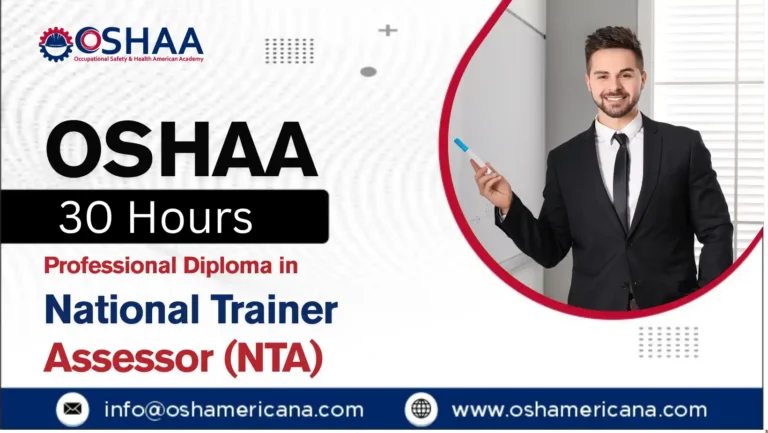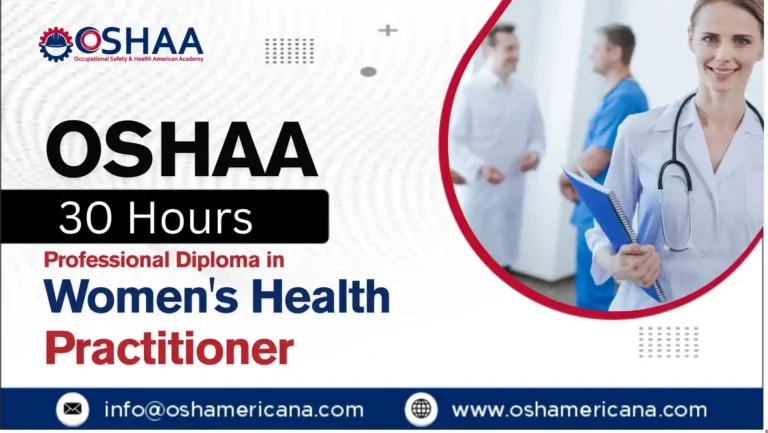Gain essential expertise with the OSHAA 30-Hours Control of Substances Hazardous to Health (COSHH) course. Ensure compliance, protect workers, and advance safety standards.
The OSHAA 30-Hours Control of Substances Hazardous to Health (COSHH) course is a comprehensive training program designed to equip professionals with the knowledge and skills required to manage hazardous substances effectively in the workplace. In industries where chemicals, biological agents, and other dangerous materials are routinely handled, ensuring compliance with COSHH regulations is not only a legal obligation but also a critical step in safeguarding employee health and organizational integrity. This course provides a structured approach to understanding the risks associated with hazardous substances and implementing the necessary control measures to minimize exposure and prevent harm.
Workplace safety is a cornerstone of sustainable operations, and the OSHAA 30-Hours Control of Substances Hazardous to Health (COSHH) course emphasizes the importance of proactive risk management. Participants will gain a deep understanding of how hazardous substances, ranging from everyday cleaning agents and pesticides to complex industrial chemicals, can impact health if not properly controlled. Prolonged or unprotected exposure to these substances can lead to serious conditions such as respiratory illnesses, skin disorders, reproductive health issues, and even life-threatening diseases like cancer. By completing this program, learners will be equipped to identify hazards, assess risks, and implement effective safety protocols that align with international standards and OSHA compliance requirements.
The OSHAA 30-Hours Control of Substances Hazardous to Health (COSHH) course is highly relevant for professionals across diverse sectors, including healthcare, manufacturing, construction, and industrial operations. It provides employees and employers with the tools to create safer working environments, reduce workplace incidents, and ensure that organizations meet both national and international safety regulations. Beyond compliance, the course fosters a culture of responsibility and awareness, empowering participants to take proactive steps in protecting themselves, their colleagues, and their organizations from the dangers posed by hazardous substances.
This program also serves as a valuable investment in professional development. By mastering the principles of COSHH, participants enhance their career prospects and demonstrate their commitment to workplace safety and regulatory excellence. For organizations, having staff trained in the OSHAA 30-Hours Control of Substances Hazardous to Health (COSHH) course means reduced risks, improved operational efficiency, and stronger reputational standing in the industry.
Ultimately, the OSHAA 30-Hours Control of Substances Hazardous to Health (COSHH) course is more than just a compliance requirement—it is a strategic step toward building safer, healthier, and more productive workplaces. By enrolling in this program, professionals and organizations alike can ensure that they are fully prepared to manage hazardous substances responsibly, protect employee well-being, and maintain the highest standards of occupational health and safety.
OSHAA 30-Hours Control of Substances Hazardous to Health (COSHH)
To enroll in the OSHAA 30-Hours Control of Substances Hazardous to Health (COSHH) course, learners are expected to meet the following criteria:
- Age Requirement
- Applicants must be at least 18 years of age to register for the OSHAA 30-Hours Control of Substances Hazardous to Health (COSHH) course. This minimum age ensures that learners possess the maturity, responsibility, and professional readiness required to engage with advanced occupational safety training and apply COSHH principles effectively in real workplace environments.
- Educational Background
- A high school diploma or equivalent qualification is recommended as the minimum educational requirement for enrolling in the OSHAA 30-Hours Control of Substances Hazardous to Health (COSHH) course. While this baseline ensures learners can understand the technical and regulatory aspects of the program, individuals with higher education in fields such as occupational health and safety, industrial safety, chemical engineering, or environmental sciences will find the course particularly advantageous. Advanced academic preparation enhances comprehension of complex safety regulations, hazardous substance management, and compliance frameworks, allowing learners to maximize the benefits of COSHH training.
- Work Experience
- Prior work experience in industries such as oil and gas, healthcare, construction, or manufacturing is not mandatory for admission into the OSHAA 30-Hours Control of Substances Hazardous to Health (COSHH) course. However, professional exposure to environments where hazardous substances are present is highly beneficial. Experienced professionals will be able to contextualize the training within their daily operations, while newcomers will gain a strong foundation in workplace safety, risk management, and OSHA compliance. This flexibility makes the course suitable for both seasoned safety practitioners and individuals seeking to build a career in occupational health and safety.
- English Proficiency
- Since the OSHAA 30-Hours Control of Substances Hazardous to Health (COSHH) course is delivered in English, learners must be able to read, write, and communicate effectively in the language. Proficiency in English is essential for understanding technical course materials, interpreting OSHA-aligned safety regulations, and applying compliance standards in professional practice. Strong language skills also ensure that participants can engage confidently with safety documentation, regulatory guidelines, and workplace communication in global industries where COSHH compliance is critical.
Meeting these eligibility requirements ensures that learners are fully prepared to benefit from the OSHAA 30-Hours Control of Substances Hazardous to Health (COSHH) course. By aligning with these standards, participants can maximize their learning outcomes, strengthen their professional credentials, and position themselves for success in managing hazardous substances, ensuring OSHA compliance, and promoting workplace safety across diverse industries. This program not only enhances individual expertise but also contributes to building safer, more compliant, and more efficient organizations worldwide.
Study Units
Learning Outcomes
Introduction to COSHH and Legal Framework (2 Hours)
- Understand the COSHH regulations and their significance in workplace health and safety.
- Identify the legal responsibilities of employers and employees under COSHH.
- Learn about the key principles of COSHH risk management and its application in different industries.
- Recognise the types of hazardous substances covered by COSHH, including chemicals, biological agents, and dust.
Identifying Hazardous Substances (4 Hours)
- Develop the ability to identify hazardous substances in the workplace.
- Understand the various categories of hazardous substances, such as toxic, corrosive, carcinogenic, and irritants.
- Learn to classify hazardous substances based on their physical, chemical, and health properties.
- Understand how to read and interpret safety data sheets (SDS) and labels for proper identification.
Risk Assessment and Control Measures (5 Hours)
- Learn how to conduct a COSHH risk assessment to evaluate potential hazards in the workplace.
- Assess the severity and likelihood of risks associated with hazardous substances.
- Identify and implement control measures to reduce exposure, such as substitution, engineering controls, and work practices.
- Develop strategies to ensure control measures are effective and regularly reviewed.
Personal Protective Equipment (PPE) for Hazardous Substances (4 Hours)
- Understand the importance of PPE in protecting workers from exposure to hazardous substances.
- Identify the different types of PPE (e.g., gloves, respirators, goggles) and their uses in different work environments.
- Learn how to select, maintain, and properly use PPE to minimise exposure risks.
- Understand the legal and organisational requirements for providing and maintaining PPE.
Safe Handling, Storage, and Disposal of Hazardous Substances (4 Hours)
- Learn the safe procedures for handling, storing, and transporting hazardous substances.
- Understand the importance of proper labelling, storage conditions, and safety signage for hazardous substances.
- Gain knowledge of how to safely dispose of hazardous substances in compliance with legal requirements.
- Learn how to prevent accidental spills, leaks, or exposures through safe storage and disposal practices.
Health Surveillance and Monitoring (4 Hours)
- Understand the role of health surveillance in detecting potential health issues related to hazardous substance exposure.
- Learn the types of health surveillance required for different substances and workplace conditions.
- Identify monitoring techniques to ensure control measures are effective in protecting worker health.
- Understand the importance of record-keeping and confidentiality in health surveillance.
Emergency Procedures and First Aid (3 Hours)
- Learn the immediate actions to take following an exposure to hazardous substances.
- Understand the importance of having clear emergency procedures in place for spills, leaks, or accidents.
- Gain knowledge of first aid measures and treatment for injuries caused by hazardous substances, such as chemical burns or inhalation.
- Develop the ability to respond quickly and efficiently to minimise harm and manage incidents effectively.
Managing and Preventing Exposure in the Workplace (4 Hours)
- Learn how to implement work practices that prevent or minimise exposure to hazardous substances.
- Understand the importance of engineering controls such as ventilation and extraction systems in reducing exposure.
- Identify administrative controls and work processes that help prevent harmful exposures.
- Develop strategies for continuous improvement in workplace safety and reducing exposure to hazardous substances.
The OSHAA 30-Hours Control of Substances Hazardous to Health (COSHH) course delivers a wide range of benefits for professionals, organizations, and stakeholders committed to workplace safety and regulatory compliance. This program is designed to provide participants with the expertise needed to manage hazardous substances effectively, reduce workplace risks, and ensure compliance with OSHA and COSHH regulations. Its global relevance makes it an essential qualification for industries such as oil and gas, healthcare, construction, and manufacturing, where exposure to hazardous chemicals and biological agents is a daily reality. By completing this course, learners not only enhance their professional development but also contribute to safer, more efficient, and legally compliant workplaces.
- Comprehensive Knowledge of Hazardous Substances
- Participants gain in-depth knowledge of hazardous substances, including chemicals, biological agents, and industrial materials. This understanding allows them to identify risks, implement control measures, and ensure compliance with COSHH regulations.
- Regulatory Compliance and Legal Protection
- The OSHAA 30-Hours Control of Substances Hazardous to Health (COSHH) course ensures learners are well-versed in OSHA and COSHH compliance standards. This knowledge protects organizations from legal penalties, regulatory violations, and reputational damage.
- Improved Workplace Safety
- By applying the principles taught in this course, professionals can significantly reduce workplace incidents caused by hazardous substances. This leads to safer operations, fewer accidents, and a stronger safety culture across the organization.
- Professional Development and Career Growth
- Completing the OSHAA 30-Hours Control of Substances Hazardous to Health (COSHH) course enhances professional credibility. It opens opportunities for career advancement in occupational health, safety management, and compliance roles across global industries.
- Operational Efficiency and Cost Savings
- Effective hazardous substance management reduces downtime, compensation claims, and equipment damage. This course equips learners with strategies that improve efficiency while maintaining high safety standards.
- Leadership and Communication Skills
- The program emphasizes leadership in safety management, enabling professionals to communicate effectively, influence teams, and foster accountability in high-risk environments.
- Enhanced Worker Well-being and Productivity
- A safe workplace directly contributes to employee well-being and higher productivity. This course empowers professionals to create environments where workers feel protected, valued, and motivated.
- Emergency Preparedness and Risk Management
- Learners develop the ability to design and implement emergency response plans for incidents such as chemical spills, leaks, or exposure. This preparedness minimizes risks and protects both lives and assets.
- Global Recognition and Industry Relevance
- The OSHAA 30-Hours Control of Substances Hazardous to Health (COSHH) course is internationally recognized, making it a valuable credential for professionals seeking opportunities in global markets. It demonstrates expertise in safety management aligned with international best practices.
- Continuous Professional Development
- The course supports lifelong learning by keeping professionals updated with evolving safety standards, technological advancements, and industry innovations in hazardous substance management.
- Risk Assessment and Control Expertise
- Participants acquire advanced skills in identifying, analyzing, and mitigating risks associated with hazardous substances. This expertise ensures safer project execution and long-term operational stability.
- Strengthened Organizational Reputation
- Companies employing professionals trained in COSHH demonstrate a strong commitment to safety and compliance, enhancing their reputation with clients, regulators, and stakeholders.
- Innovation in Safety Practices
- The program encourages continuous improvement and innovation in safety management, equipping professionals to adopt new technologies and strategies that enhance workplace safety.
- Cross-Industry Applicability
- While focused on hazardous substances, the skills gained from the OSHAA 30-Hours Control of Substances Hazardous to Health (COSHH) course are transferable to other high-risk industries, broadening career opportunities for graduates.
- Contribution to Sustainable Operations
- By promoting safety, compliance, and efficiency, this course supports sustainable business practices that protect both people and the environment, aligning with global sustainability goals.
The OSHAA 30-Hours Control of Substances Hazardous to Health (COSHH) course is more than just a compliance requirement—it is a strategic investment in professional growth, organizational resilience, and global safety standards. By completing this program, learners gain the expertise to ensure OSHA compliance, reduce workplace risks, and drive operational excellence, making it an essential qualification for professionals and organizations worldwide.
The OSHAA 30-Hours Control of Substances Hazardous to Health (COSHH) course is designed for professionals, organizations, and stakeholders who are directly or indirectly involved in managing hazardous substances in the workplace. This program is highly relevant for individuals across industries such as oil and gas, healthcare, construction, and manufacturing, where exposure to chemicals, biological agents, and industrial materials is a daily reality. By focusing on OSHA compliance, global safety standards, and professional development, the course equips participants with the expertise to reduce risks, ensure regulatory adherence, and promote a culture of workplace safety. It is an essential qualification for those seeking to enhance their careers, strengthen organizational safety systems, and contribute to sustainable operational excellence.
- Safety Managers
- Oversee workplace safety programs and ensure compliance with OSHA and COSHH regulations.
- This course provides them with advanced knowledge of hazardous substance management and risk control.
- They gain the ability to implement effective safety systems that reduce incidents and improve compliance.
- The training enhances their leadership role in promoting workplace safety and operational efficiency.
- Operations Supervisors
- Responsible for daily oversight of industrial, construction, or oil and gas operations.
- The course equips them with tools to integrate COSHH safety protocols into operational workflows.
- They learn to identify hazards, enforce compliance, and improve team safety performance.
- This training ensures OSHA-aligned operations that balance productivity with worker protection.
- HSE Officers (Health, Safety, and Environment Officers)
- Monitor and enforce workplace safety standards across industries.
- The OSHAA 30-Hours Control of Substances Hazardous to Health (COSHH) course strengthens their ability to conduct audits and risk assessments.
- They gain deeper insights into OSHA compliance and international safety frameworks.
- This enhances their capacity to protect employees, assets, and the environment.
- Engineers and Technical Staff
- Involved in designing, maintaining, and operating industrial systems and processes.
- The course helps them understand how engineering decisions impact hazardous substance control.
- They acquire skills to integrate safety considerations into technical operations.
- This ensures compliance with OSHA standards while improving reliability and efficiency.
- Project Managers
- Lead large-scale projects in oil and gas, construction, and manufacturing sectors.
- The program provides strategies to manage safety risks throughout project lifecycles.
- They learn to balance deadlines and budgets with compliance and worker safety.
- This training supports OSHA-aligned project execution and sustainable outcomes.
- Contractors and Subcontractors
- Frequently engaged in high-risk tasks involving hazardous substances.
- The course ensures they understand and comply with OSHA and COSHH safety requirements.
- They gain the ability to align practices with client safety expectations.
- This enhances their credibility and reduces liability in contractual engagements.
- Healthcare Professionals
- Work in environments where exposure to biological agents and chemicals is common.
- The course equips them with knowledge to manage risks associated with hazardous substances.
- They gain skills to protect themselves, patients, and colleagues from exposure.
- This training ensures compliance with OSHA standards in healthcare settings.
- Regulatory and Compliance Officers
- Ensure organizations meet local and international safety regulations.
- The OSHAA 30-Hours Control of Substances Hazardous to Health (COSHH) course deepens their understanding of compliance frameworks.
- They gain the ability to monitor, evaluate, and enforce safety standards effectively.
- This strengthens organizational resilience and reduces regulatory risks.
- Training and Development Specialists
- Design and deliver workforce training programs in safety and compliance.
- The course provides updated knowledge of OSHA-aligned COSHH practices.
- They can create effective training modules that improve worker awareness.
- This ensures continuous professional development and compliance across the workforce.
- Aspiring Safety Professionals
- Individuals seeking to build a career in occupational health and safety.
- The course provides them with a strong foundation in hazardous substance management.
- They gain a competitive advantage in securing roles within high-risk industries.
- This qualification demonstrates commitment to OSHA compliance and professional growth.
The OSHAA 30-Hours Control of Substances Hazardous to Health (COSHH) course equips participants across all roles with advanced knowledge, practical skills, and globally recognized certification. By completing this program, professionals enhance their ability to ensure OSHA compliance, reduce workplace risks, and drive operational excellence. Whether for safety managers, engineers, healthcare workers, or aspiring professionals, this diploma serves as a vital credential that strengthens careers, supports organizational success, and contributes to building safer, more sustainable workplaces worldwide.







